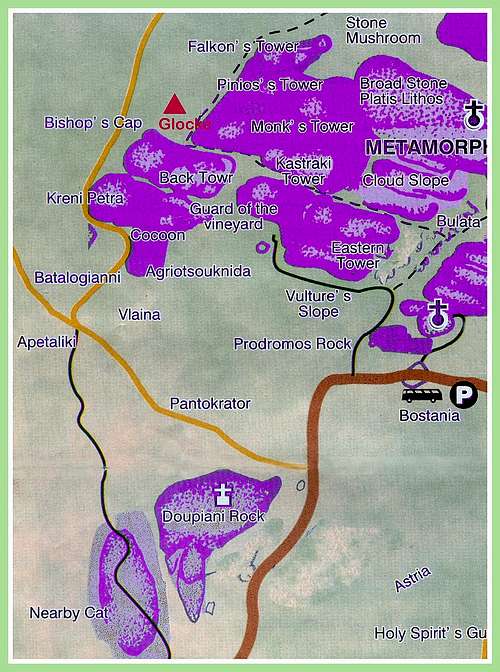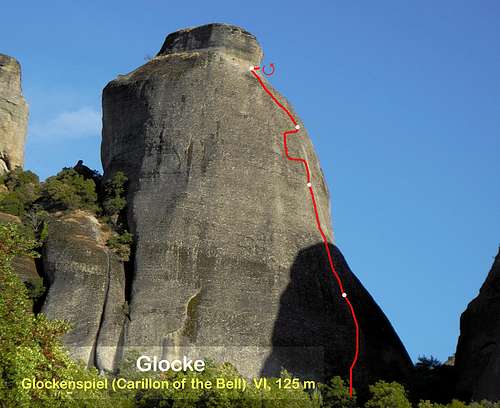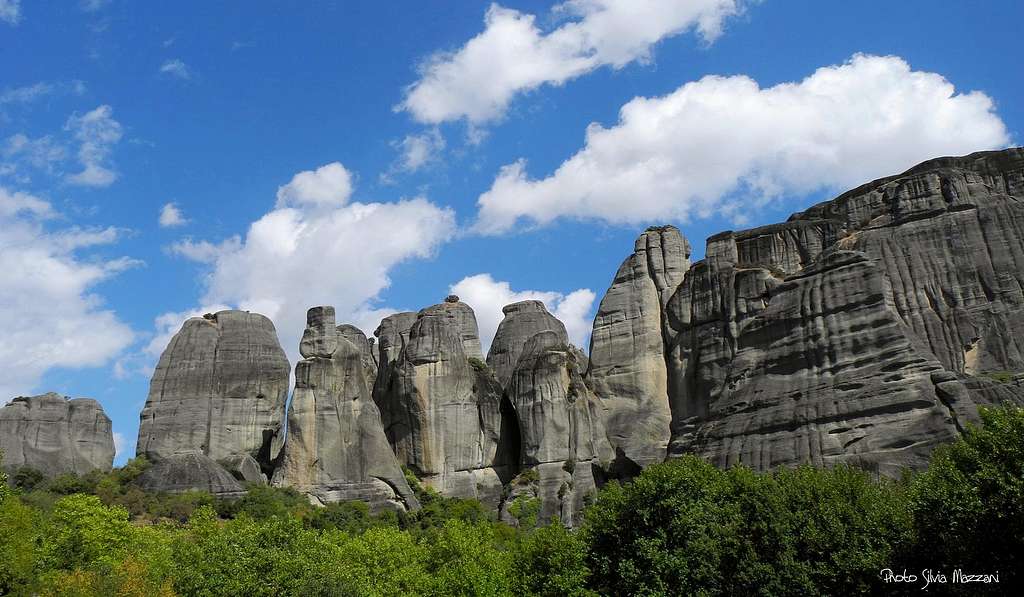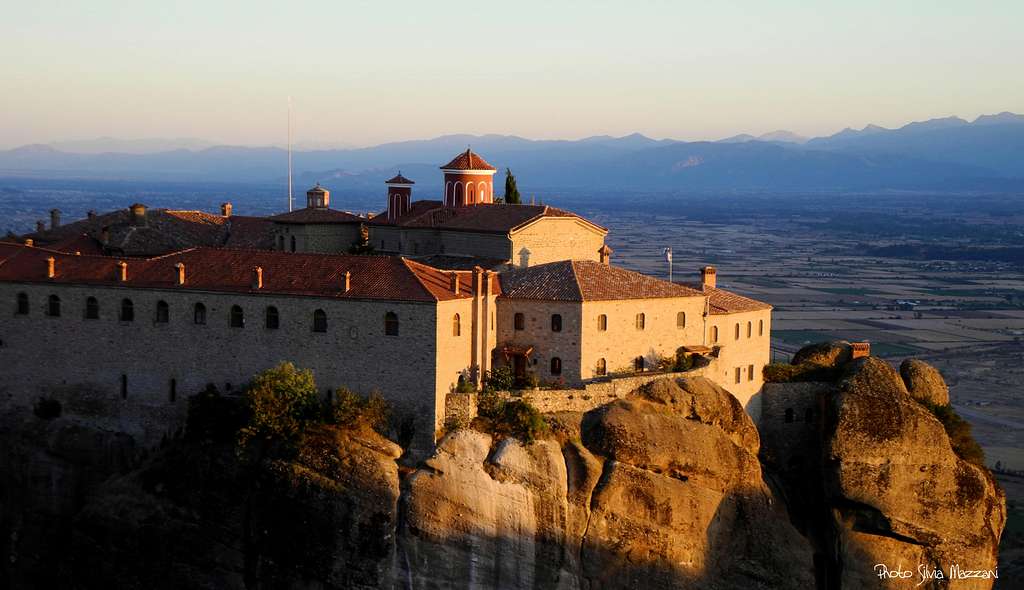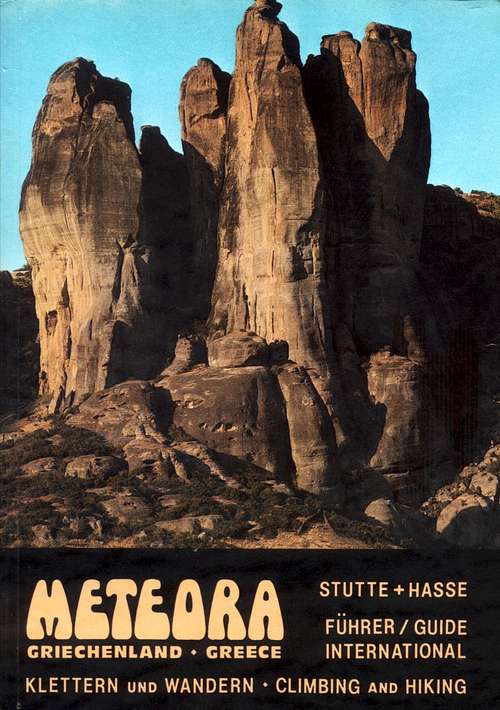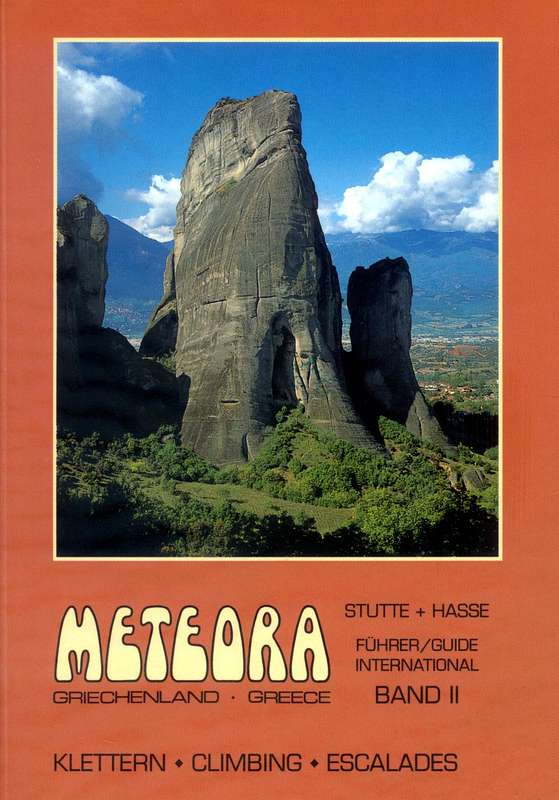-
 6104 Hits
6104 Hits
-
 88.19% Score
88.19% Score
-
 26 Votes
26 Votes
|
|
Mountain/Rock |
|---|---|
|
|
39.72260°N / 21.61665°E |
|
|
Thessaly |
|
|
Trad Climbing |
|
|
Spring, Fall |
|
|
1640 ft / 500 m |
|
|
Overview
Glocke/The Bell
It doesn't mean if you call it "Glocke" in German or "The Bell" in English, this tower resembling a huge bell is definitely one of the best rock climbing destination in the Meteora (Μετέωρα) area, whose meaning is literally "hanging in the air". Meteora is a charming and intriguing climbing site located in the Thessaly region of Greece, including about 170 conglomerate summits of various shapes and types, as massive mountains, rocky pinnacles, minor peaks and spires, some of which are truly amazing and bizarre. The towers overlook the village of Kastràki and the town of Kalambàka and feature about 850 multi-pitch and single pitch routes. The towers of Meteora are quite famous all over the world, due to their singularity and a bit of mistery surrounding the place, in addition to the presence of various monasteries.
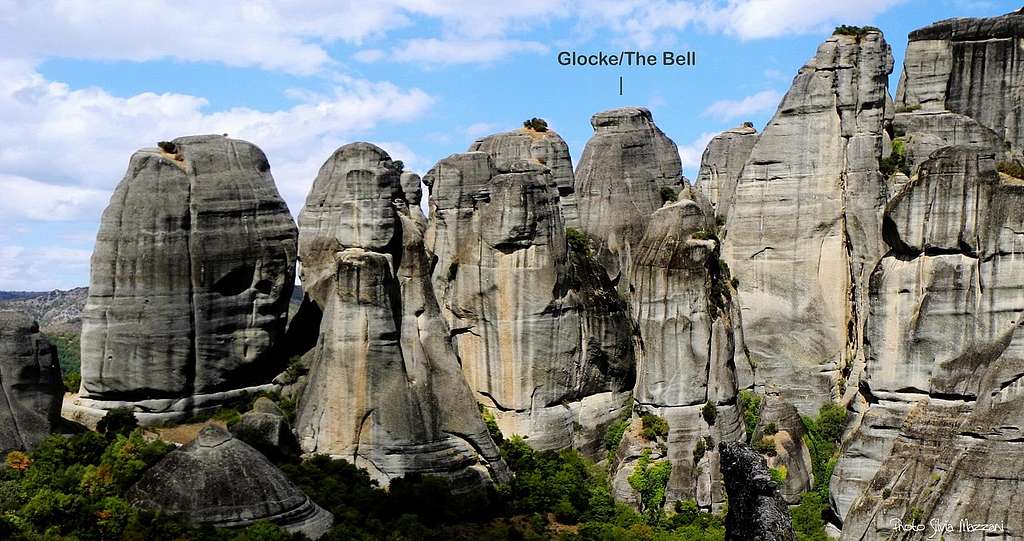
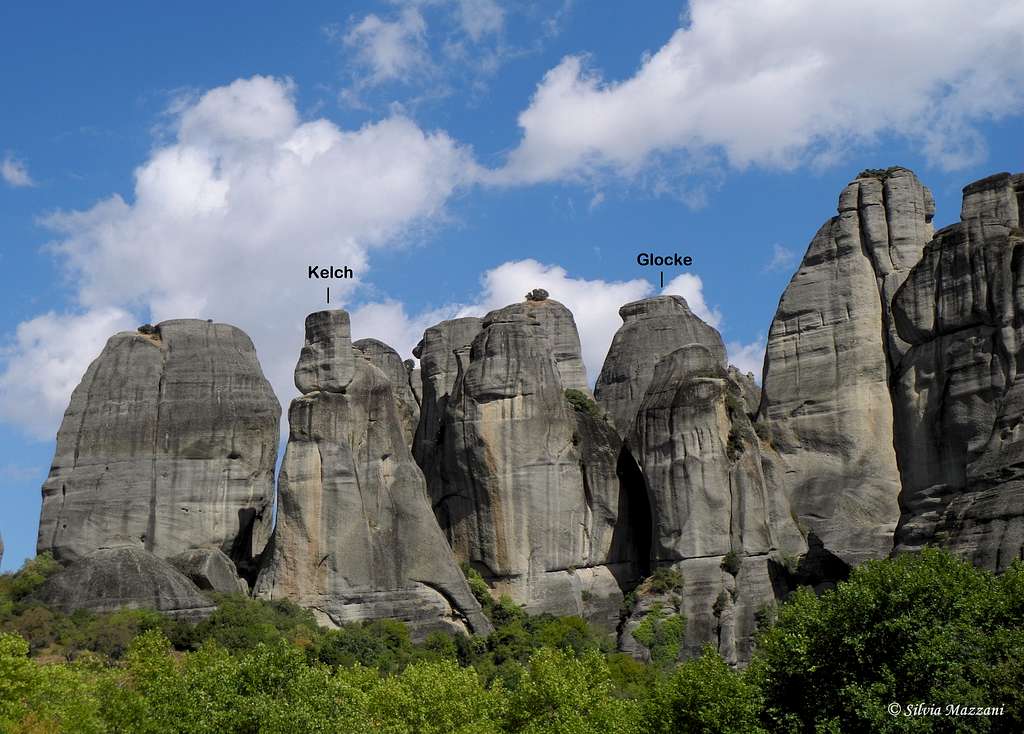
"Glocke" is a suggestive dome belonging to the Western Group, located on the West border of Meteora area, North to Doupiani, a well known tower which is usually well suited as a reference point, being located just on the left along the main road directed to the monasteries. "Glocke" has fairly good rock quality. It counts a fine classic and well attended route - Glockenspiel aka Carillon of the Bell - and some modern ones. Moreover it has the benefit of presenting a simple and fast approach.
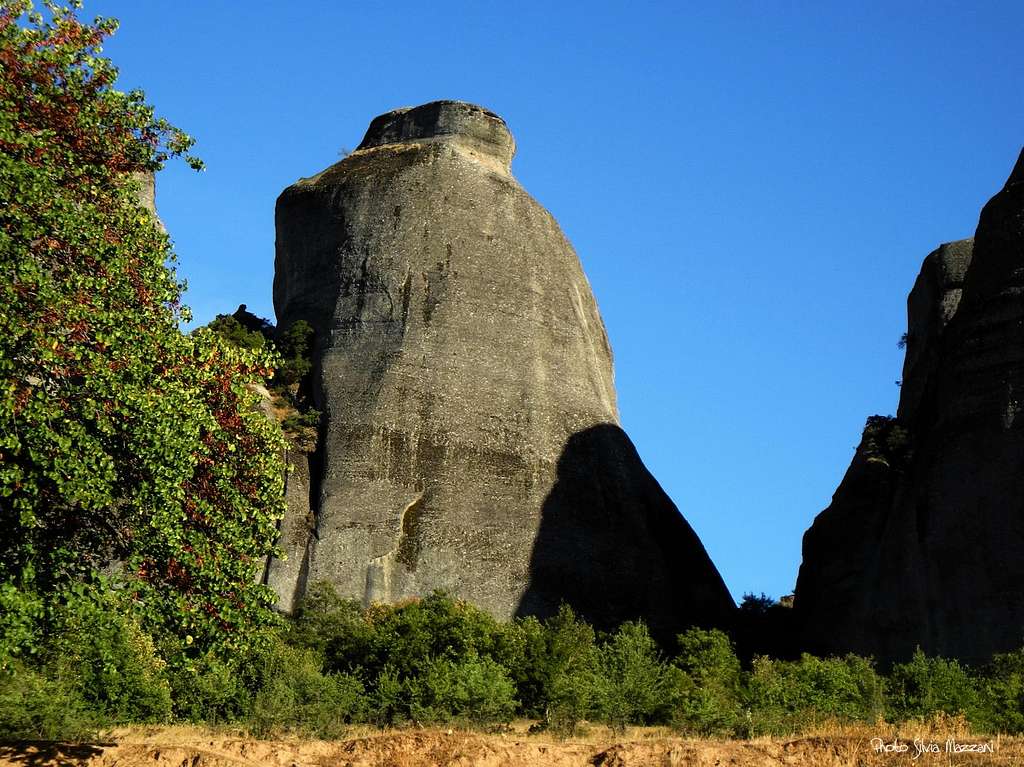
Getting There
Meteora is situated in the Thessaly region of Greece, Northern half of Greece, approximately 25 km NNW from Trikala, and immediately North of Kalambaka and Kastraki, the two main towns in the area, both located very close to the rocks. The closest main town is Larissa. The distance to Kalambaka is about 360 km from Athens and 237 km. from Thessaloníki.
By plane - Meteora can be approached from Athens Eleftherios Venizelos airport or from Thessaloniki airport. From these airports you can:
- take a domestic flight to Larissa (about 85 km from Kalambaka)
- rent a car, useful once you are in Kastraki, but not essential
- use public transports (bus or train). Getting to Meteora without a car is easy thanks to the train from Athens that stops in Kalambaka.
By ferry from Italy – If you wish to travel with your own car, there are different shipping companies and many ferries departures to Igoumenitza from the harbours of Ancona, Bari and Brindisi.
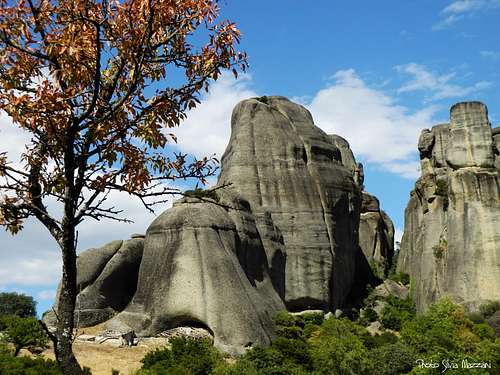
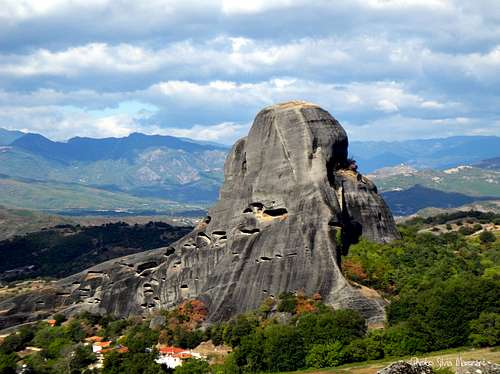
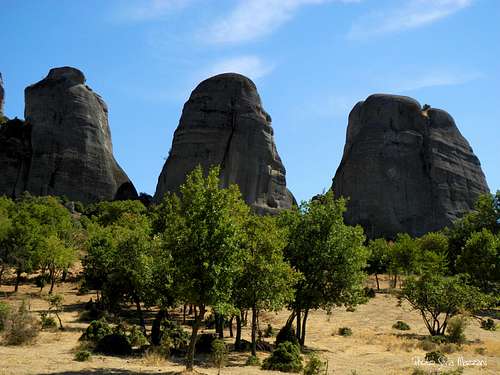
Walking approach
Glocke is quite easily and briefly approached. From Kastraki, head to Northeast along the main road directed towards the monasteries. Just after the Doupiani tower, situated on the left side of the road, there is a parking lot on the left. Leave the car here and walk onto a dirt road on the left rising uphill to a col. Here it starts a mule track turning right to skirt the Western side of Meteora Western group. As the Bell is just visible about 200 m to the right (southeast), leave the mule-track and start to walk along a field and a small wood in the direction ot the unmistakable tower (15 min from the parking lot).
Glockenspiel (Carillon of the Bell) route report
Glockenspiel (Carillon of the Bell) (UIAA scale)
A superb classic route! It's located on the right of the most modern routes running on the same face. Despite the fact that the climbing degree is lower than the adjacent modern routes, Glockenspiel is a bit more demanding as the protections are poorer.
Once getting the base of the wall, skirt it to an obvious attack area located to the right of the two modern routes.
L1 - Climb up the wall increasingly steeper, at first directly then in slight oblique to the left, V-, 30 m
L2 - Continue straight to the stance below a vertical wall, V +, 20 m
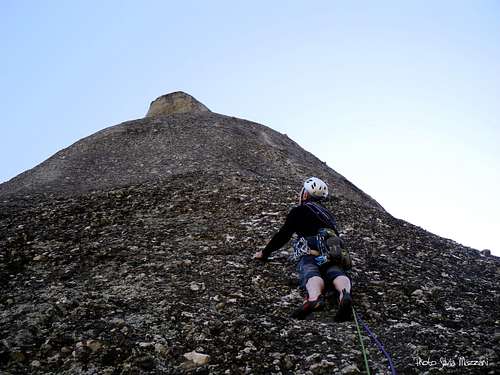
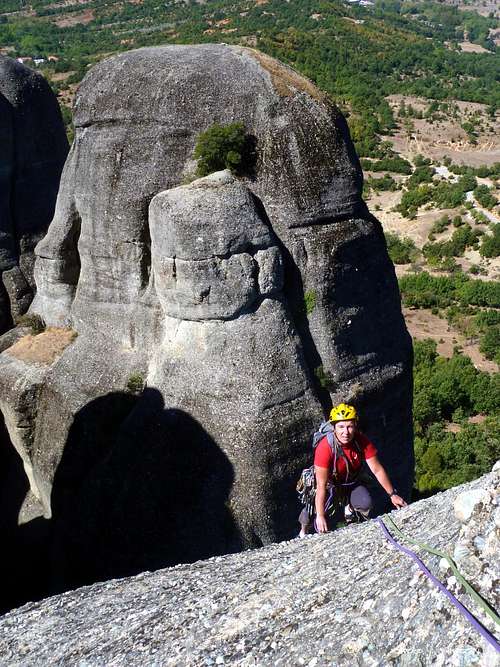
L3 - A challenging pitch. Straight up to the first peg, then slanting left to pass the key move and then turn to right to the stance, VI-, 25 m
L4 - Continue slanting left with decreasing difficulties to get the stance under the characteristic summit cowl, V, then IV, 20 m.
L5 - From the stance traverse rightward for a long way to skirt the overhanging band at the base of the summit cowl, so to take the East wall of the tower, bypass and edge and finally climb up in the easier point and stop, IV-, 20 m
L6 - To the left on a ramp surmounted by a small overhang, then rightward briefly to the magnificent top. Summit book.
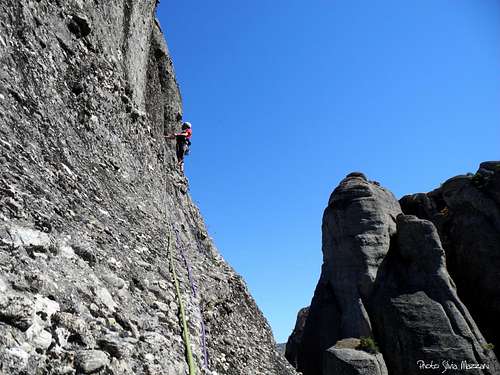

Descent - From the summit with two equipped abseils (20 m + 35 m) on the North-East side (opposite to the SW wall just climbed) and reach a narrow saddle, from which turn rightward to enter a vegetated gully (with a tunnel at the beginning), leading to a saddle from where turning again to the right you come back to the start of the climb.
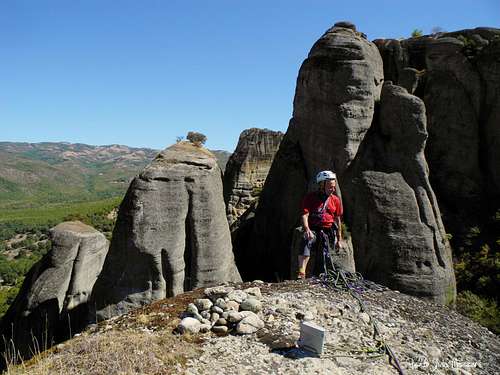
Other routes
Besides "Carillon of the Bell", there are some other interesting routes on Glocke:
SW wall (the same wall on which it runs "Carillon of the Bell")
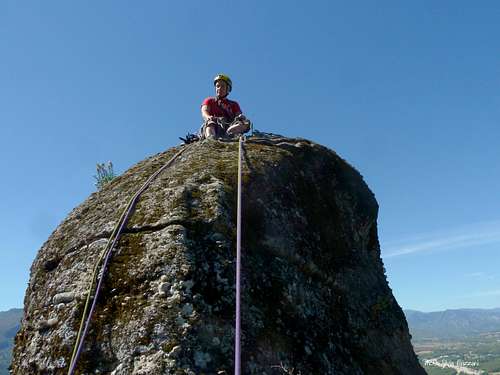
Starting from left we meet:
- Pathfinder 6b+, 100 m (3 pitches) - A modern and well-equipped route up a hard wall P1: 6a+ 40m A steep slab - P2: 6b 30m Steep wall P3: 6b+ 30m Small overhang - First ascent: Jorgos Vaiou and Telis Giannis 5-6-1999
- Alemannischer Schelledanz 6c, 100 m (4 pitches) - With little respect toward the first climbers and really poor taste, the original route had been renamed Interamerican (Direct) (a large insurance agency), being one of the best protected routes in Meteora. P1: 6a 35m A vertical wall. P2: 6a+ 30m Directly up the wall to a bulge. P3: 6a 20m A steep slab to a break below the Bell cap. P4: 6c 15m A small overhang. A 4b variation traverse left - First ascent: Gunther Rieth, T. Kluge 31-10-90
- Carillon of the Bell Direct 6c 100m (4 pitches). The classic Glockenspiel (Carillon of the Bell) revisited: the first two pitches are the same as the classic route, the third pitch had been straightened and well equipped, then instead of traversing right the variation directly ends as the previous route. P1: 5c 30m, 4 bolts. A steep slab. P2: 5b 20m, 3 bolts. Bigger cobbles on this slab. P3: 6a 40m, 8 bolts. A steep wall with an easier variation to the right. P4: 6c 15m Finishes as for Direct finish by M. Mittasch, J. Wunsche, J. Gerald 1992
South wall
- Bohmische Klingel VI+, 150 m (6 pitches) - First ascent: Jarda Koncàk and R. Holcak 18-8 1986
East wall
- Ostweg VI-, 60 m - A brief route climbing a chimney crack on the East face, then traversing right toward the North side and here exiting to the summit
- Wandvariante IV+ - An easier variant on the right of Ostweg chimney crack, joining the previous route in the final
Red Tape
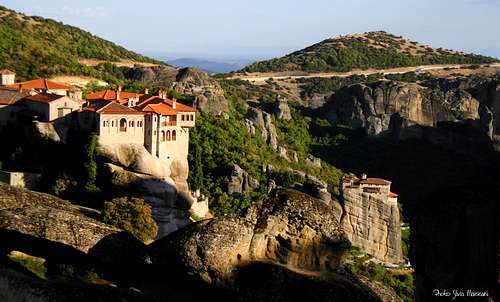
No fees and no permits required. Anyhow, if you are visiting this area, remember not to climb on rock formations with inhabited monasteries. In the Seventies Dietrich Hasse and his team decided, in agreement with local authorities, not to climb any route on these latter rock formations. This rule applies even today. Please preserve all other historical remains. Another important suggestion is not to add fixed protections on the classic routes to the pre-existing ones. If you plan to visit the monasteries, keep in mind to be appropriately dressed: men cannot wear shorts, while women must wear long skirts and not trousers, arms must be covered. Since the year 1988 Meteora was declared a Meteora Unesco World Heritage Site .
Rock climbing and Geology
Basically Meteora is not a place for lovers of sport climbing. The nature of the rock is very peculiar, the pegs often very spaced, especially on the classic routes of the pioneers, every routes ends on a true summit that involves rappels. The magnificent surroundings and the ambience make the climbing at Meteora a singular experience. All the towers and spires in Meteora, even the smallest, have a summit book and as a rule usually have two names (and sometimes plus the English version): the local name in Greek and the German name. The genesis of the German name is explained by the broad activity of East German pioneers. The rock is a gray-brown conglomerate. It is believed that the needles began to form in the Tertiary - about 60 million years ago - starting from the materials deposited at the border of the Thessaly plain when the prehistoric sea waters, which previously covered the plain, withdrew. Slowly the conglomerates needle were then sculpted over the millennia, by water, wind and earthquakes.
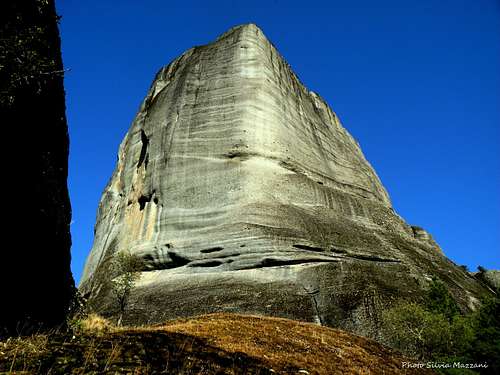
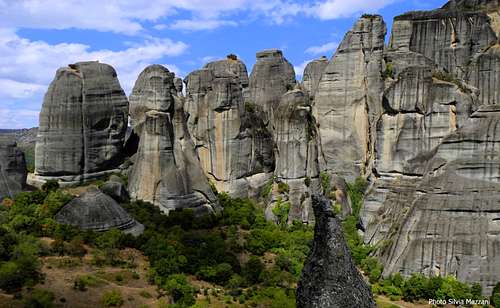
The texture of Meteora rock results from a mix of pebbles, cobbles and larger stones, packed into a rock surface which is a mixture of conglomerate and sandstone. Sometimes the cobbles have come out from the rock to leave shallow holes in their place. The rock is predominantly solid and reliable. What emerges is a peculiar climbing style, mainly slabby and balancy on cobbles, consisting in exploiting small or large pebbles protruding, or otherwise the holes remained where the same pebbles were formerly located. As soon as you get used to it, the climb will provide fun and generally little tiring.
Nature and climate
The vegetation is considered as supra-Mediterranean, with climax cover of Quercus and Ostrya species and Fagus sylvatica beech forest above 700 m. The area includes forested hills and river valley covered by forests of Platanus orientalis and species such as the endemic Centaurea lactifolia (Centaurea kalambakensi).
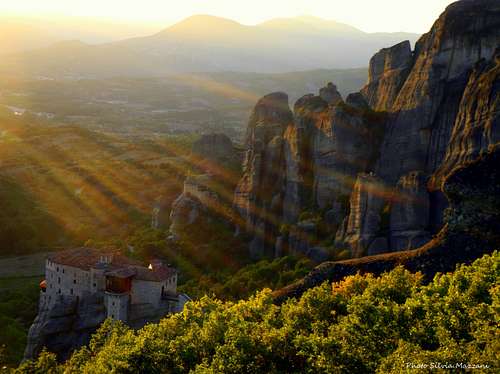

Meteora during the summer is affected by the climate of the tropics, extending its influence into the Mediterranean area and therefore a great heat can be expected, while during the winter the area is influenced by the Central Europe climate, that often produces changes from fair weather conditions to bad weather conditions. Best seasons are the middle ones: Spring till the end of May and early and middle Fall.
A bit of history
The first people to climb these extraordinary towers were hermits in the 11th or maybe 12th century. The construction of the monasteries started began in the 14th century. By the end of the 15th century, 24 monasteries crowned the summits of Meteora. The first hermits climbed up by using scaffolds, later rope ladders and net was used, until the first wooden ladders took over in the early 20th century. Currently, only six monasteries are inhabited. Since the Seventies a group of German climbers, in primis the physicist Dietrich Hasse and the photographer Heinz Lothar Stutte, began to explore the mountain range and climbed almost all the most important summits, with the exception of the towers on which lie the monasteries. Their background from Sächsische Schweiz explains the reason of their climbing style by using only very few protections and with a very rigorous ethic. The same climbers realized two climbing guides of the area.
When to Climb
Virtually you could climb all year round (snowfalls are rare), with the warning that summer is really very hot and in winter the temperatures may be unpleasant, unless you are very lucky. The best months are late March, April, May, September, October and November.
Accomodation
There are a great number of hotel rooms, B&Bs and rooms to rent in the village of Kastraki, the village built in the shadow of the Meteora towers. The nearby town of Kalabaka also features many accomodation choices. There are also three organized campsites, amongst which the nearest one to the crags is Camping Vrachos in Kastraki. There is also a smaller campsite near the tower of Doupiani. There are plenty of eating out options, particularly tasty traditional Greek food and pizzerias, both in Kastraki and Kalambaka.
Meteo
External Links
Guidebooks and maps
|
Meteora
Heinz Lothar Stutte - Dietrich Hasse
Climbing and hiking guidebook I edition 1986 - German and English
The basic guidebook to climb and hike in Meteora
|
|
|
Meteora
Heinz Lothar Stutte - Dietrich Hasse
Climbing guidebook II edition 2000 - II edition not a complete guidebook, but an update to the I edition - German, Greek and English
ISBN3-922066-05-4
|
There are two useful guidebooks to consult:
“Meteora – Climbing and hiking” by Dietrich Hasse and Heinz Lothar Stutte - I edition 1986, in English and German. It contains around 230 routes. Also, it provides general information about mountaineering, hiking in Meteora, maps, directions.
“Meteora Climbing Part II” by the same Heinz Lothar Stutte and Dietrich Hasse – II edition 2000 – German, Greek and English - Note: the II edition is not a complete guidebook, but an update to the I edition
The Meteora guidebooks can be purchased in Kastraki, Taverna Paradisos or Camping Vrachos. There is also a useful map by the same authors that can be purchased in local shops in Kastraki.
Maps
